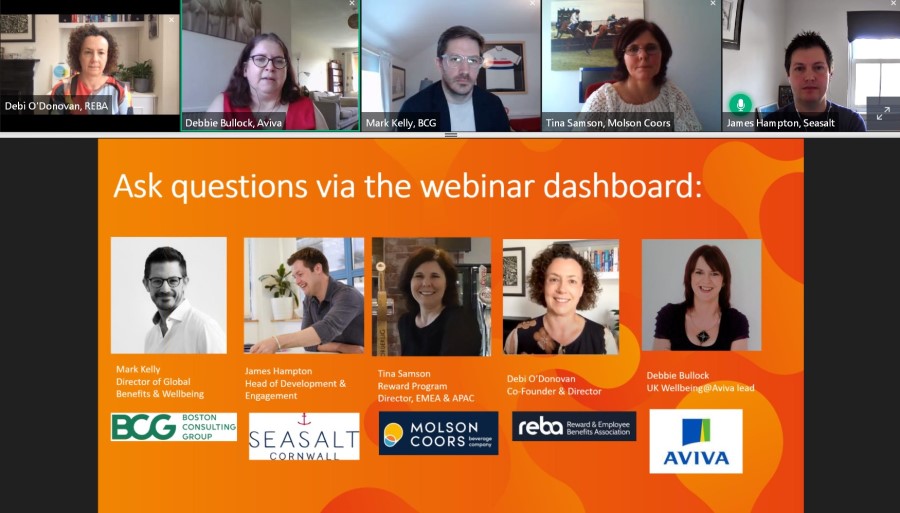Tackling the wellbeing needs of non-office workers: practical tips from Molson Coors and Seasalt

A key topic covered in REBA’s recent webinar on mental wellbeing in a time of change: strategies to manage burnout, pressure and motivation in your dispersed workforce was looking at how to support non-office-based employees. Tina Samson, reward programme director at brewers Molson Coors, and James Hampton, head of development and engagement at clothing business Seasalt, offered some practical tips and advice.
A listening strategy
The needs of employees are, unsurprisingly, quite diverse and so for both Hampton and Samson implementing a robust listening strategy is critical to identifying employee need.
“We do a lot of listening sessions to get feedback from employees. Our mental health champions who we’ve got across the business and are in those areas [non-office environments] are regularly feeding back to us about the things that we can do,” says Samson. “It’s about getting their feedback and reacting quite quickly to it.”
Hampton agrees, adding that it’s important to understand what is going on in each area of your business so you can develop an appropriate action. “The action is really important because a listening strategy without any doing is kind of pointless – so we are pushing that a little bit harder this year.
“We have a listening strategy that we would normal run, but we’re now taking a much more localised approach to that rather than a whole business approach, which is helping us to get more information,” he adds.
Line managers are also very important because they are closest to the employee. They should be given the skills and training to enable conversations with employees, understand individual’s stressors and know how to help them.
Practical support for all
Engaging employees with their benefits can be difficult, particularly when they work in an environment where they are not online. Samson highlighted how they communicate with their production staff in a different way to get messages about the tools and support they have available to them.
“We use things like posters to get messages out. We use QR codes so that employees can easily go on to their personal mobile phone and give us a pulse on what they want to see [from their benefits],” says Samson.
It’s not just thinking about how benefits are communicated but also whom they include.
“We’ve opened our mental health app up to family not just employees,” says Samson. “It’s not just about the employee. It’s about the employee feeling like their whole wellbeing is comfortable, and if they aren’t then they know what tools and resources are available for them and their family to help them.”
Another factor that Hampton believes is important is to consider what the real issues are, rather than trying lots of different benefits and support, and hoping that it works.
“We want to know from our people what they would like and what support they need so that we address real, fundamental, foundation issues – core causes of wellbeing burnout, stress and anxiety – rather than hearing about things that others say is good and chucking it at people,” he says.
This approach again goes back to the underlying need to listen and respond to employees’ needs.
Returning to the workplace
Looking to the months ahead, one of the biggest challenges will be supporting employees as they return to the workplace, either from an extended period of furlough or working from the office for the first time in months.
To date, Molson Coors has been supporting its furloughed employees by sharing training on resilience and stress. “So whilst they cannot physically be in work, they can do training from time to time, so we’ve done things specifically for them,” explains Samson.
Beyond that, both Samson and Hampton say they are aware that people will feel differently about returning to the workplace, and they will need to take steps to understand people’s concerns and needs.
“We’re really conscious that coming back – when the trade starts to open – they’re [employees] going to have different pressure points. They’re going to be in front of customers who have been through such a challenging time and so again it’s tailoring those [wellbeing] messages to them.”
Hampton adds: “We have to continually assess and evaluate all of the time, and keep our doors open.”
Top tips for supporting mental wellbeing in times of change:
- It’s not just about the employee – consider opening up benefits such as employee assistance programmes and mental health apps to family members.
- Develop a listening culture in all areas of the business and respond quickly.
- Tailor your comms strategy for the working environment, such as posters with QR codes to enable production staff to access information on their personal devices, and webinars for desk-based staff.
- Make sure your employee representatives – whether they are wellbeing champions/mental health first aiders etc – are visible and accessible to employees.
- Continue to train and support those on furlough – remaining connected to the business will be important for when they return.
- Try to address fundamental, foundation issues rather than treat symptoms of stress, pressure and burnout.
- Line managers should be aware of the external pressures on their direct line reports and know how they can help them.
- Continually assess, evaluate and keep your doors open to employees.
For more on this topic, watch the full webinar on Mental wellbeing in a time of change: strategies to manage burnout, pressure and motivation in your dispersed workforce.
The author is Dawn Lewis, content editor at REBA.





